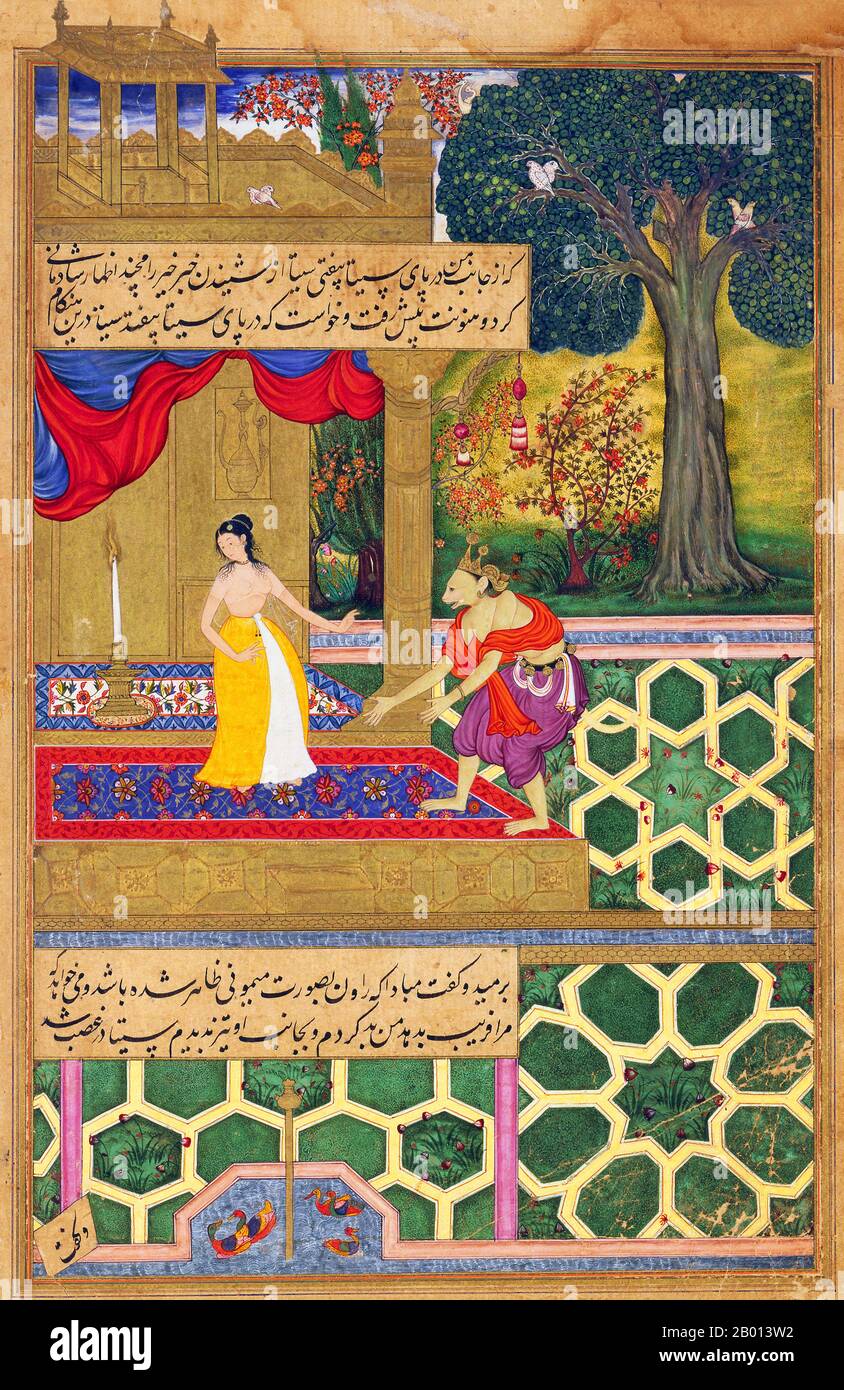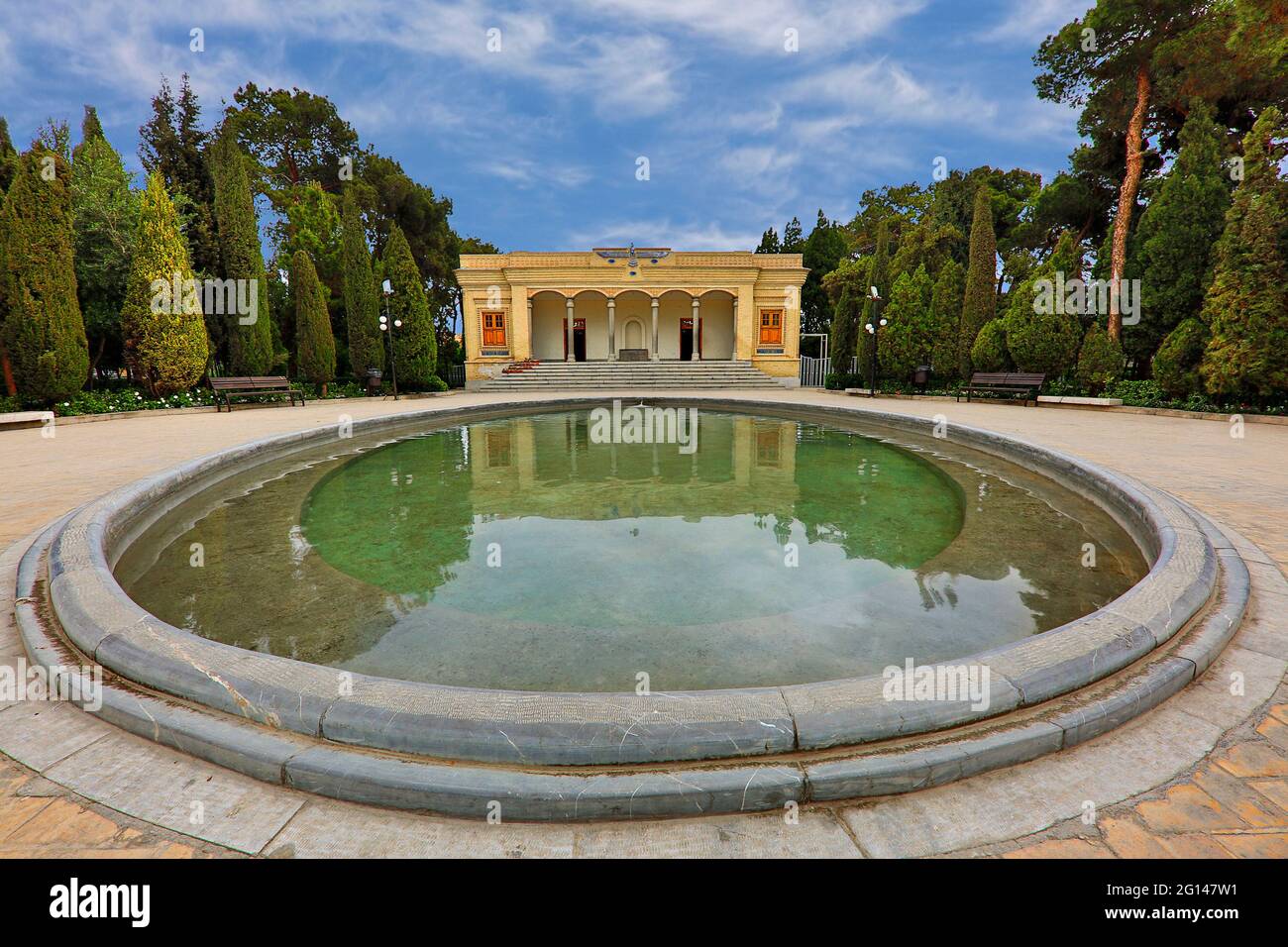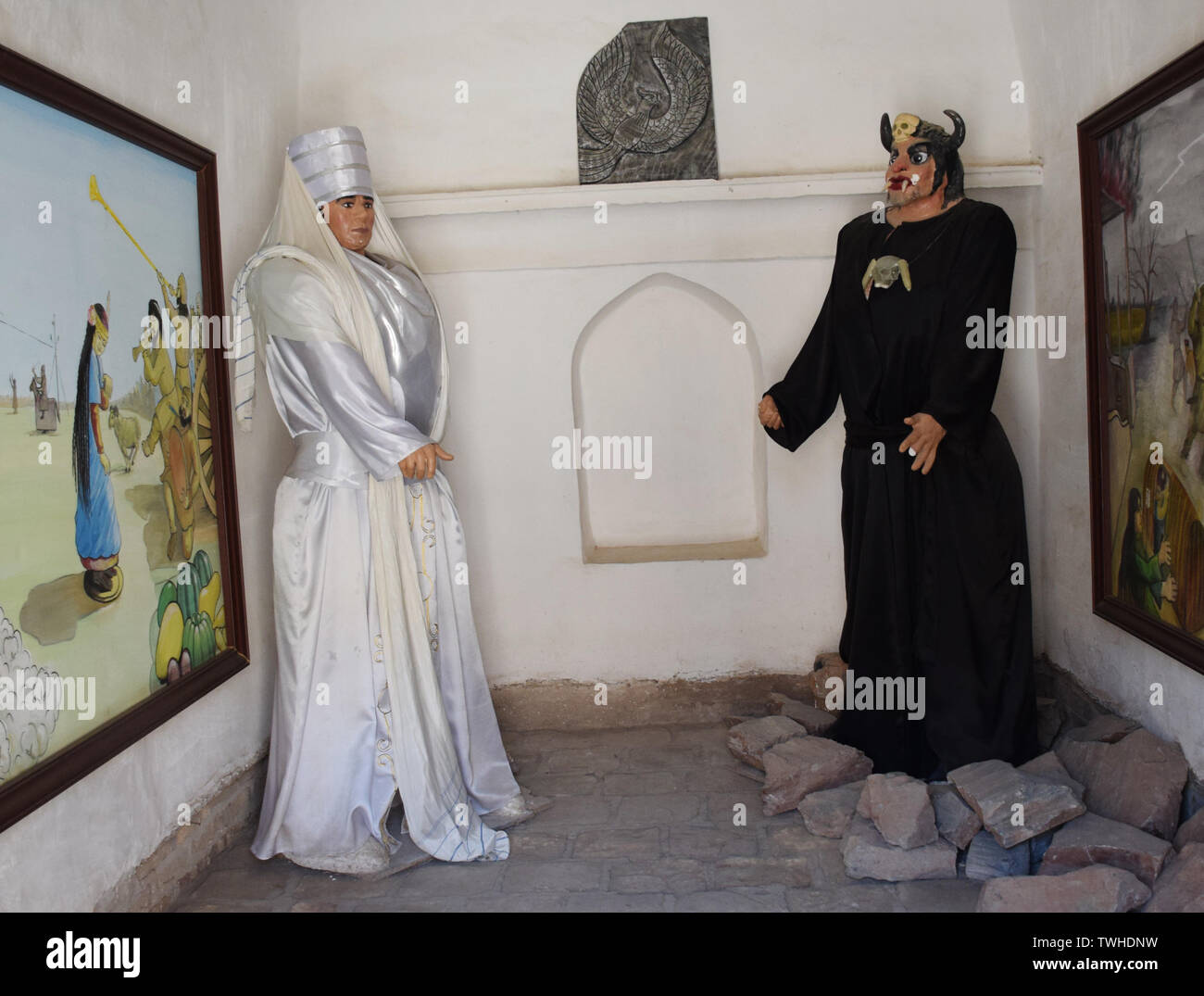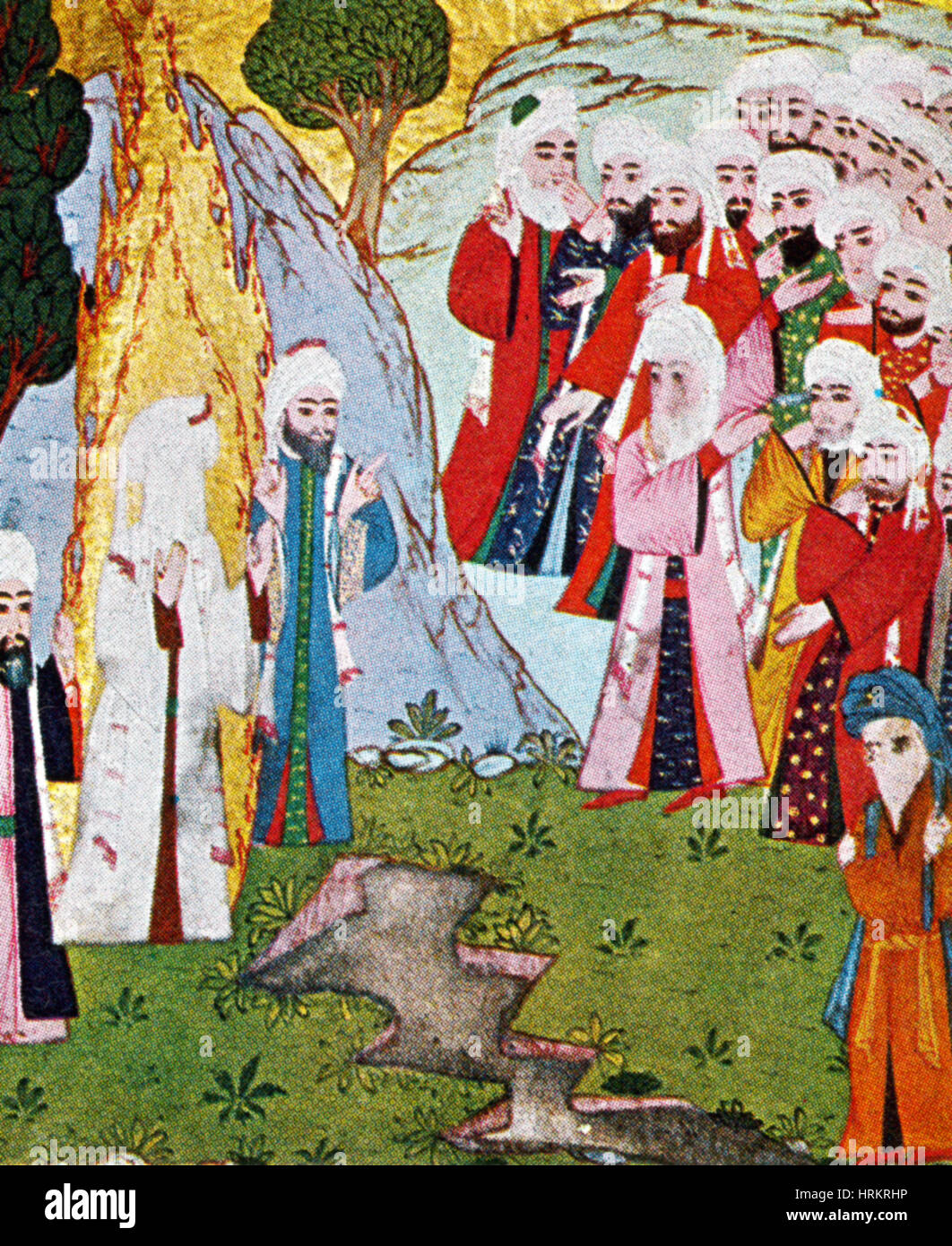Persian god of evil Stock Photos and Images
 This illustration dates to around 1898 and depicts the sculpture of Mithras (also spelled Mithra) that is housed in the Vatican. Mithras is sometimes known as the bull slaughterer and bull slayer. Followers of Mithras believed that the world was created from the blood of a bull, so the symbolism here is that of Mithras slitting the throat of the bull. The serpent represent evil forces in typical depictions of the Mithras story. Mithras was a deity in the Persian religion known as Mithraism. He was worshiped as the god of the sun, justice, and war. He later became a god worshiped in Rome and in Stock Photohttps://www.alamy.com/image-license-details/?v=1https://www.alamy.com/stock-photo-this-illustration-dates-to-around-1898-and-depicts-the-sculpture-of-176172749.html
This illustration dates to around 1898 and depicts the sculpture of Mithras (also spelled Mithra) that is housed in the Vatican. Mithras is sometimes known as the bull slaughterer and bull slayer. Followers of Mithras believed that the world was created from the blood of a bull, so the symbolism here is that of Mithras slitting the throat of the bull. The serpent represent evil forces in typical depictions of the Mithras story. Mithras was a deity in the Persian religion known as Mithraism. He was worshiped as the god of the sun, justice, and war. He later became a god worshiped in Rome and in Stock Photohttps://www.alamy.com/image-license-details/?v=1https://www.alamy.com/stock-photo-this-illustration-dates-to-around-1898-and-depicts-the-sculpture-of-176172749.htmlRFM6HA3W–This illustration dates to around 1898 and depicts the sculpture of Mithras (also spelled Mithra) that is housed in the Vatican. Mithras is sometimes known as the bull slaughterer and bull slayer. Followers of Mithras believed that the world was created from the blood of a bull, so the symbolism here is that of Mithras slitting the throat of the bull. The serpent represent evil forces in typical depictions of the Mithras story. Mithras was a deity in the Persian religion known as Mithraism. He was worshiped as the god of the sun, justice, and war. He later became a god worshiped in Rome and in
 Mithras (a Greek god) emerging from an egg bearing a sword and torch to combat evil. The egg is the symbol of eternity. (3rd century AD). Stock Photohttps://www.alamy.com/image-license-details/?v=1https://www.alamy.com/stock-photo-mithras-a-greek-god-emerging-from-an-egg-bearing-a-sword-and-torch-104000377.html
Mithras (a Greek god) emerging from an egg bearing a sword and torch to combat evil. The egg is the symbol of eternity. (3rd century AD). Stock Photohttps://www.alamy.com/image-license-details/?v=1https://www.alamy.com/stock-photo-mithras-a-greek-god-emerging-from-an-egg-bearing-a-sword-and-torch-104000377.htmlRMG15HF5–Mithras (a Greek god) emerging from an egg bearing a sword and torch to combat evil. The egg is the symbol of eternity. (3rd century AD).
 India: 'Sita Shies Away from Hanuman, Believing He is Ravana in Disguise'. Miniature painting from the Ramayana, c. 1594. The Mughal Emperor Akbar (r. 1556-1605) was known for his religious tolerance, and had holy Hindu scriptures translated into Persian. He presented the magnificent copy of the Ramayana from which this miniature comes to his mother in 1594. Sita, wife of the protagonist, Rama, has been captured by the evil demon Ravana. In this scene a frightened Sita begins to doubt whether it really is her good friend, the monkey general Hanuman, standing before her. Stock Photohttps://www.alamy.com/image-license-details/?v=1https://www.alamy.com/india-sita-shies-away-from-hanuman-believing-he-is-ravana-in-disguise-miniature-painting-from-the-ramayana-c-1594-the-mughal-emperor-akbar-r-1556-1605-was-known-for-his-religious-tolerance-and-had-holy-hindu-scriptures-translated-into-persian-he-presented-the-magnificent-copy-of-the-ramayana-from-which-this-miniature-comes-to-his-mother-in-1594-sita-wife-of-the-protagonist-rama-has-been-captured-by-the-evil-demon-ravana-in-this-scene-a-frightened-sita-begins-to-doubt-whether-it-really-is-her-good-friend-the-monkey-general-hanuman-standing-before-her-image344232366.html
India: 'Sita Shies Away from Hanuman, Believing He is Ravana in Disguise'. Miniature painting from the Ramayana, c. 1594. The Mughal Emperor Akbar (r. 1556-1605) was known for his religious tolerance, and had holy Hindu scriptures translated into Persian. He presented the magnificent copy of the Ramayana from which this miniature comes to his mother in 1594. Sita, wife of the protagonist, Rama, has been captured by the evil demon Ravana. In this scene a frightened Sita begins to doubt whether it really is her good friend, the monkey general Hanuman, standing before her. Stock Photohttps://www.alamy.com/image-license-details/?v=1https://www.alamy.com/india-sita-shies-away-from-hanuman-believing-he-is-ravana-in-disguise-miniature-painting-from-the-ramayana-c-1594-the-mughal-emperor-akbar-r-1556-1605-was-known-for-his-religious-tolerance-and-had-holy-hindu-scriptures-translated-into-persian-he-presented-the-magnificent-copy-of-the-ramayana-from-which-this-miniature-comes-to-his-mother-in-1594-sita-wife-of-the-protagonist-rama-has-been-captured-by-the-evil-demon-ravana-in-this-scene-a-frightened-sita-begins-to-doubt-whether-it-really-is-her-good-friend-the-monkey-general-hanuman-standing-before-her-image344232366.htmlRM2B013W2–India: 'Sita Shies Away from Hanuman, Believing He is Ravana in Disguise'. Miniature painting from the Ramayana, c. 1594. The Mughal Emperor Akbar (r. 1556-1605) was known for his religious tolerance, and had holy Hindu scriptures translated into Persian. He presented the magnificent copy of the Ramayana from which this miniature comes to his mother in 1594. Sita, wife of the protagonist, Rama, has been captured by the evil demon Ravana. In this scene a frightened Sita begins to doubt whether it really is her good friend, the monkey general Hanuman, standing before her.
 A friend's letter, 17th-18th centuries, Calligraphy, Arabic, Calligraphy, Persian, Manuscripts, Persian, Washington (D.C.), Iran, Arabic script calligraphy, Illuminated Islamic manuscripts, Islamic calligraphy, Islamic manuscripts, Shikastah, Nasta'liq, A letter composed for a friend, in Persian written in shikastah-nasta'liq script with four bayts (verses) of a lyrical poem (ghazal) from Firdawsi's 'Shahnamah' from 19th Cent Iran., Dimensions of Written Surface: 5.8 (h) x 11.9 (w) cm, The text is written in small black shikastah-nasta'liq script on a piece of paper painted in light brown in s Stock Photohttps://www.alamy.com/image-license-details/?v=1https://www.alamy.com/a-friends-letter-17th-18th-centuries-calligraphy-arabic-calligraphy-persian-manuscripts-persian-washington-dc-iran-arabic-script-calligraphy-illuminated-islamic-manuscripts-islamic-calligraphy-islamic-manuscripts-shikastah-nastaliq-a-letter-composed-for-a-friend-in-persian-written-in-shikastah-nastaliq-script-with-four-bayts-verses-of-a-lyrical-poem-ghazal-from-firdawsis-shahnamah-from-19th-cent-iran-dimensions-of-written-surface-58-h-x-119-w-cm-the-text-is-written-in-small-black-shikastah-nastaliq-script-on-a-piece-of-paper-painted-in-light-brown-in-s-image624753345.html
A friend's letter, 17th-18th centuries, Calligraphy, Arabic, Calligraphy, Persian, Manuscripts, Persian, Washington (D.C.), Iran, Arabic script calligraphy, Illuminated Islamic manuscripts, Islamic calligraphy, Islamic manuscripts, Shikastah, Nasta'liq, A letter composed for a friend, in Persian written in shikastah-nasta'liq script with four bayts (verses) of a lyrical poem (ghazal) from Firdawsi's 'Shahnamah' from 19th Cent Iran., Dimensions of Written Surface: 5.8 (h) x 11.9 (w) cm, The text is written in small black shikastah-nasta'liq script on a piece of paper painted in light brown in s Stock Photohttps://www.alamy.com/image-license-details/?v=1https://www.alamy.com/a-friends-letter-17th-18th-centuries-calligraphy-arabic-calligraphy-persian-manuscripts-persian-washington-dc-iran-arabic-script-calligraphy-illuminated-islamic-manuscripts-islamic-calligraphy-islamic-manuscripts-shikastah-nastaliq-a-letter-composed-for-a-friend-in-persian-written-in-shikastah-nastaliq-script-with-four-bayts-verses-of-a-lyrical-poem-ghazal-from-firdawsis-shahnamah-from-19th-cent-iran-dimensions-of-written-surface-58-h-x-119-w-cm-the-text-is-written-in-small-black-shikastah-nastaliq-script-on-a-piece-of-paper-painted-in-light-brown-in-s-image624753345.htmlRM2Y8BY7D–A friend's letter, 17th-18th centuries, Calligraphy, Arabic, Calligraphy, Persian, Manuscripts, Persian, Washington (D.C.), Iran, Arabic script calligraphy, Illuminated Islamic manuscripts, Islamic calligraphy, Islamic manuscripts, Shikastah, Nasta'liq, A letter composed for a friend, in Persian written in shikastah-nasta'liq script with four bayts (verses) of a lyrical poem (ghazal) from Firdawsi's 'Shahnamah' from 19th Cent Iran., Dimensions of Written Surface: 5.8 (h) x 11.9 (w) cm, The text is written in small black shikastah-nasta'liq script on a piece of paper painted in light brown in s
 Zoroastrian fire temple in Yazd, Iran Stock Photohttps://www.alamy.com/image-license-details/?v=1https://www.alamy.com/zoroastrian-fire-temple-in-yazd-iran-image430967853.html
Zoroastrian fire temple in Yazd, Iran Stock Photohttps://www.alamy.com/image-license-details/?v=1https://www.alamy.com/zoroastrian-fire-temple-in-yazd-iran-image430967853.htmlRF2G147W1–Zoroastrian fire temple in Yazd, Iran
 . Babel and Bible;. Fig. 51. Angels with Human Heads.(Noble types closely resembling the Christian conception of angels.) But the demons and the devils, whether they takefor us the form of the enemies of man or that of theprimordial foes of God,—to these we were destined to bidfarewell for all eternity, for the ancient Persian dualismwas not after our hearts. I form the light and createdarkness : I make peace and create evil: it is /, Yahveh,that do all these things. So justly declares the greatest 56 BABEL AND BIBLE. prophet of the Old Testament, Isaiah (xlv. 7). Demonslike that represented i Stock Photohttps://www.alamy.com/image-license-details/?v=1https://www.alamy.com/babel-and-bible-fig-51-angels-with-human-headsnoble-types-closely-resembling-the-christian-conception-of-angels-but-the-demons-and-the-devils-whether-they-takefor-us-the-form-of-the-enemies-of-man-or-that-of-theprimordial-foes-of-godto-these-we-were-destined-to-bidfarewell-for-all-eternity-for-the-ancient-persian-dualismwas-not-after-our-hearts-i-form-the-light-and-createdarkness-i-make-peace-and-create-evil-it-is-yahvehthat-do-all-these-things-so-justly-declares-the-greatest-56-babel-and-bible-prophet-of-the-old-testament-isaiah-xlv-7-demonslike-that-represented-i-image370458951.html
. Babel and Bible;. Fig. 51. Angels with Human Heads.(Noble types closely resembling the Christian conception of angels.) But the demons and the devils, whether they takefor us the form of the enemies of man or that of theprimordial foes of God,—to these we were destined to bidfarewell for all eternity, for the ancient Persian dualismwas not after our hearts. I form the light and createdarkness : I make peace and create evil: it is /, Yahveh,that do all these things. So justly declares the greatest 56 BABEL AND BIBLE. prophet of the Old Testament, Isaiah (xlv. 7). Demonslike that represented i Stock Photohttps://www.alamy.com/image-license-details/?v=1https://www.alamy.com/babel-and-bible-fig-51-angels-with-human-headsnoble-types-closely-resembling-the-christian-conception-of-angels-but-the-demons-and-the-devils-whether-they-takefor-us-the-form-of-the-enemies-of-man-or-that-of-theprimordial-foes-of-godto-these-we-were-destined-to-bidfarewell-for-all-eternity-for-the-ancient-persian-dualismwas-not-after-our-hearts-i-form-the-light-and-createdarkness-i-make-peace-and-create-evil-it-is-yahvehthat-do-all-these-things-so-justly-declares-the-greatest-56-babel-and-bible-prophet-of-the-old-testament-isaiah-xlv-7-demonslike-that-represented-i-image370458951.htmlRM2CEKT4R–. Babel and Bible;. Fig. 51. Angels with Human Heads.(Noble types closely resembling the Christian conception of angels.) But the demons and the devils, whether they takefor us the form of the enemies of man or that of theprimordial foes of God,—to these we were destined to bidfarewell for all eternity, for the ancient Persian dualismwas not after our hearts. I form the light and createdarkness : I make peace and create evil: it is /, Yahveh,that do all these things. So justly declares the greatest 56 BABEL AND BIBLE. prophet of the Old Testament, Isaiah (xlv. 7). Demonslike that represented i
 shiraz, Iran - march 27, 2017: photos of church building in shiraz Stock Photohttps://www.alamy.com/image-license-details/?v=1https://www.alamy.com/shiraz-iran-march-27-2017-photos-of-church-building-in-shiraz-image416540737.html
shiraz, Iran - march 27, 2017: photos of church building in shiraz Stock Photohttps://www.alamy.com/image-license-details/?v=1https://www.alamy.com/shiraz-iran-march-27-2017-photos-of-church-building-in-shiraz-image416540737.htmlRF2F5K1XW–shiraz, Iran - march 27, 2017: photos of church building in shiraz
 Statues of Ahura Mazda and Angra Mainyu: two principle figures of Zoroastrianism , an age old central Asian/ Silk Road Monotheistic religion. Stock Photohttps://www.alamy.com/image-license-details/?v=1https://www.alamy.com/statues-of-ahura-mazda-and-angra-mainyu-two-principle-figures-of-zoroastrianism-an-age-old-central-asian-silk-road-monotheistic-religion-image256695541.html
Statues of Ahura Mazda and Angra Mainyu: two principle figures of Zoroastrianism , an age old central Asian/ Silk Road Monotheistic religion. Stock Photohttps://www.alamy.com/image-license-details/?v=1https://www.alamy.com/statues-of-ahura-mazda-and-angra-mainyu-two-principle-figures-of-zoroastrianism-an-age-old-central-asian-silk-road-monotheistic-religion-image256695541.htmlRFTWHDNW–Statues of Ahura Mazda and Angra Mainyu: two principle figures of Zoroastrianism , an age old central Asian/ Silk Road Monotheistic religion.
 The stained glass windows of the Narenjistan-e qavam or Qavam Orangery, Shiraz Iran. Stock Photohttps://www.alamy.com/image-license-details/?v=1https://www.alamy.com/stock-photo-the-stained-glass-windows-of-the-narenjistan-e-qavam-or-qavam-orangery-15966090.html
The stained glass windows of the Narenjistan-e qavam or Qavam Orangery, Shiraz Iran. Stock Photohttps://www.alamy.com/image-license-details/?v=1https://www.alamy.com/stock-photo-the-stained-glass-windows-of-the-narenjistan-e-qavam-or-qavam-orangery-15966090.htmlRFAR7MPK–The stained glass windows of the Narenjistan-e qavam or Qavam Orangery, Shiraz Iran.
 The god Mithras slaying the great bull. The spilling of the bull's blood was believed to bring about the rebirth of light and life. The dog and the snake which try to lick the blood are both featured prominently in Persian religious imagery, as does the s Stock Photohttps://www.alamy.com/image-license-details/?v=1https://www.alamy.com/stock-photo-the-god-mithras-slaying-the-great-bull-the-spilling-of-the-bulls-blood-104000385.html
The god Mithras slaying the great bull. The spilling of the bull's blood was believed to bring about the rebirth of light and life. The dog and the snake which try to lick the blood are both featured prominently in Persian religious imagery, as does the s Stock Photohttps://www.alamy.com/image-license-details/?v=1https://www.alamy.com/stock-photo-the-god-mithras-slaying-the-great-bull-the-spilling-of-the-bulls-blood-104000385.htmlRMG15HFD–The god Mithras slaying the great bull. The spilling of the bull's blood was believed to bring about the rebirth of light and life. The dog and the snake which try to lick the blood are both featured prominently in Persian religious imagery, as does the s
 . The history of the devil and the idea of evil; from the earliest times to the present day . out theslightest hesitation to the in-fluence of evil spirits. Tertullian is also aware of manysimilarities between Church institutions and the paganmodes of Mithras worship, which observation prompted him to declare that Satan imi-tates the sacraments of God.tThe Devil appears to have beenvery cunning in those daj^s, forif he had not daring spies inheaven, he must himself haveanticipated the Lords plans ; forthe pagan institutions spokenof as Satanic imitations, such as the Persian haoma sacri-fice, Stock Photohttps://www.alamy.com/image-license-details/?v=1https://www.alamy.com/the-history-of-the-devil-and-the-idea-of-evil-from-the-earliest-times-to-the-present-day-out-theslightest-hesitation-to-the-in-fluence-of-evil-spirits-tertullian-is-also-aware-of-manysimilarities-between-church-institutions-and-the-paganmodes-of-mithras-worship-which-observation-prompted-him-to-declare-that-satan-imi-tates-the-sacraments-of-godtthe-devil-appears-to-have-beenvery-cunning-in-those-dajs-forif-he-had-not-daring-spies-inheaven-he-must-himself-haveanticipated-the-lords-plans-forthe-pagan-institutions-spokenof-as-satanic-imitations-such-as-the-persian-haoma-sacri-fice-image369761497.html
. The history of the devil and the idea of evil; from the earliest times to the present day . out theslightest hesitation to the in-fluence of evil spirits. Tertullian is also aware of manysimilarities between Church institutions and the paganmodes of Mithras worship, which observation prompted him to declare that Satan imi-tates the sacraments of God.tThe Devil appears to have beenvery cunning in those daj^s, forif he had not daring spies inheaven, he must himself haveanticipated the Lords plans ; forthe pagan institutions spokenof as Satanic imitations, such as the Persian haoma sacri-fice, Stock Photohttps://www.alamy.com/image-license-details/?v=1https://www.alamy.com/the-history-of-the-devil-and-the-idea-of-evil-from-the-earliest-times-to-the-present-day-out-theslightest-hesitation-to-the-in-fluence-of-evil-spirits-tertullian-is-also-aware-of-manysimilarities-between-church-institutions-and-the-paganmodes-of-mithras-worship-which-observation-prompted-him-to-declare-that-satan-imi-tates-the-sacraments-of-godtthe-devil-appears-to-have-beenvery-cunning-in-those-dajs-forif-he-had-not-daring-spies-inheaven-he-must-himself-haveanticipated-the-lords-plans-forthe-pagan-institutions-spokenof-as-satanic-imitations-such-as-the-persian-haoma-sacri-fice-image369761497.htmlRM2CDG2FN–. The history of the devil and the idea of evil; from the earliest times to the present day . out theslightest hesitation to the in-fluence of evil spirits. Tertullian is also aware of manysimilarities between Church institutions and the paganmodes of Mithras worship, which observation prompted him to declare that Satan imi-tates the sacraments of God.tThe Devil appears to have beenvery cunning in those daj^s, forif he had not daring spies inheaven, he must himself haveanticipated the Lords plans ; forthe pagan institutions spokenof as Satanic imitations, such as the Persian haoma sacri-fice,
 shiraz, Iran - march 27, 2017: photos of church building in shiraz Stock Photohttps://www.alamy.com/image-license-details/?v=1https://www.alamy.com/shiraz-iran-march-27-2017-photos-of-church-building-in-shiraz-image416540720.html
shiraz, Iran - march 27, 2017: photos of church building in shiraz Stock Photohttps://www.alamy.com/image-license-details/?v=1https://www.alamy.com/shiraz-iran-march-27-2017-photos-of-church-building-in-shiraz-image416540720.htmlRF2F5K1X8–shiraz, Iran - march 27, 2017: photos of church building in shiraz
 Muhammad Brings Forth A Spring in Mecca Stock Photohttps://www.alamy.com/image-license-details/?v=1https://www.alamy.com/stock-photo-muhammad-brings-forth-a-spring-in-mecca-135045282.html
Muhammad Brings Forth A Spring in Mecca Stock Photohttps://www.alamy.com/image-license-details/?v=1https://www.alamy.com/stock-photo-muhammad-brings-forth-a-spring-in-mecca-135045282.htmlRMHRKRHP–Muhammad Brings Forth A Spring in Mecca
 . The history of the devil and the idea of evil; from the earliest times to the present day . The Doom OF THE Damned. (After Luca Signorelli.) The Gnostic Christian view of Doomsday and Hellembodies many ancient traditions of Egyptian, Indian,and Persian mj-thology and foreshadows at the same timethe later Roman Catholic view as represented in medi-aeval art, finding its poetical consummation in DantesDivina Coinedia. Satan was regarded by the early Christians as the 190 THE HISTORY OF THE DEVIL.. The Trinity Ideal of Medi.eval Christianity. (Old German.)Representing God as Emperor, Christ as Stock Photohttps://www.alamy.com/image-license-details/?v=1https://www.alamy.com/the-history-of-the-devil-and-the-idea-of-evil-from-the-earliest-times-to-the-present-day-the-doom-of-the-damned-after-luca-signorelli-the-gnostic-christian-view-of-doomsday-and-hellembodies-many-ancient-traditions-of-egyptian-indianand-persian-mj-thology-and-foreshadows-at-the-same-timethe-later-roman-catholic-view-as-represented-in-medi-aeval-art-finding-its-poetical-consummation-in-dantesdivina-coinedia-satan-was-regarded-by-the-early-christians-as-the-190-the-history-of-the-devil-the-trinity-ideal-of-medieval-christianity-old-germanrepresenting-god-as-emperor-christ-as-image369782256.html
. The history of the devil and the idea of evil; from the earliest times to the present day . The Doom OF THE Damned. (After Luca Signorelli.) The Gnostic Christian view of Doomsday and Hellembodies many ancient traditions of Egyptian, Indian,and Persian mj-thology and foreshadows at the same timethe later Roman Catholic view as represented in medi-aeval art, finding its poetical consummation in DantesDivina Coinedia. Satan was regarded by the early Christians as the 190 THE HISTORY OF THE DEVIL.. The Trinity Ideal of Medi.eval Christianity. (Old German.)Representing God as Emperor, Christ as Stock Photohttps://www.alamy.com/image-license-details/?v=1https://www.alamy.com/the-history-of-the-devil-and-the-idea-of-evil-from-the-earliest-times-to-the-present-day-the-doom-of-the-damned-after-luca-signorelli-the-gnostic-christian-view-of-doomsday-and-hellembodies-many-ancient-traditions-of-egyptian-indianand-persian-mj-thology-and-foreshadows-at-the-same-timethe-later-roman-catholic-view-as-represented-in-medi-aeval-art-finding-its-poetical-consummation-in-dantesdivina-coinedia-satan-was-regarded-by-the-early-christians-as-the-190-the-history-of-the-devil-the-trinity-ideal-of-medieval-christianity-old-germanrepresenting-god-as-emperor-christ-as-image369782256.htmlRM2CDH114–. The history of the devil and the idea of evil; from the earliest times to the present day . The Doom OF THE Damned. (After Luca Signorelli.) The Gnostic Christian view of Doomsday and Hellembodies many ancient traditions of Egyptian, Indian,and Persian mj-thology and foreshadows at the same timethe later Roman Catholic view as represented in medi-aeval art, finding its poetical consummation in DantesDivina Coinedia. Satan was regarded by the early Christians as the 190 THE HISTORY OF THE DEVIL.. The Trinity Ideal of Medi.eval Christianity. (Old German.)Representing God as Emperor, Christ as
 shiraz, Iran - march 27, 2017: photos of church building in shiraz Stock Photohttps://www.alamy.com/image-license-details/?v=1https://www.alamy.com/shiraz-iran-march-27-2017-photos-of-church-building-in-shiraz-image416540727.html
shiraz, Iran - march 27, 2017: photos of church building in shiraz Stock Photohttps://www.alamy.com/image-license-details/?v=1https://www.alamy.com/shiraz-iran-march-27-2017-photos-of-church-building-in-shiraz-image416540727.htmlRF2F5K1XF–shiraz, Iran - march 27, 2017: photos of church building in shiraz